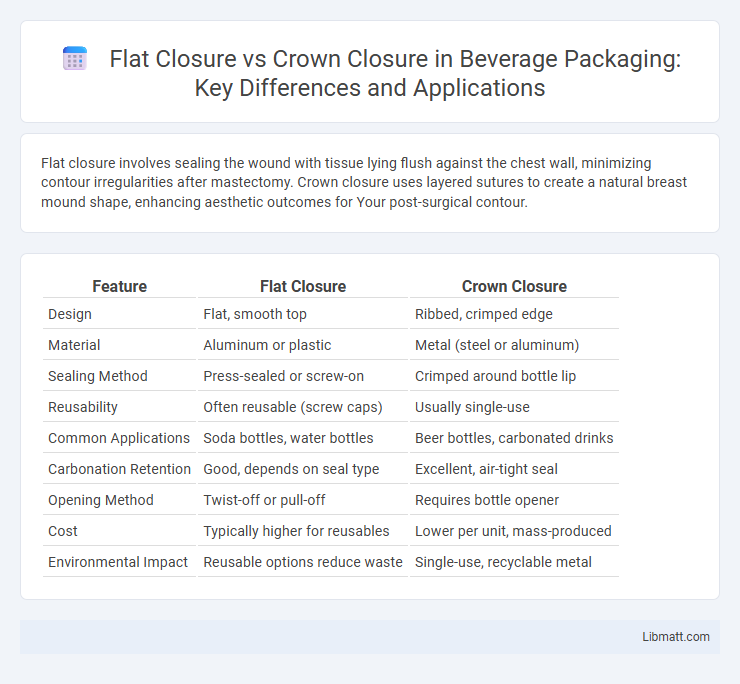Flat closure involves sealing the wound with tissue lying flush against the chest wall, minimizing contour irregularities after mastectomy. Crown closure uses layered sutures to create a natural breast mound shape, enhancing aesthetic outcomes for Your post-surgical contour.
Table of Comparison
| Feature | Flat Closure | Crown Closure |
|---|---|---|
| Design | Flat, smooth top | Ribbed, crimped edge |
| Material | Aluminum or plastic | Metal (steel or aluminum) |
| Sealing Method | Press-sealed or screw-on | Crimped around bottle lip |
| Reusability | Often reusable (screw caps) | Usually single-use |
| Common Applications | Soda bottles, water bottles | Beer bottles, carbonated drinks |
| Carbonation Retention | Good, depends on seal type | Excellent, air-tight seal |
| Opening Method | Twist-off or pull-off | Requires bottle opener |
| Cost | Typically higher for reusables | Lower per unit, mass-produced |
| Environmental Impact | Reusable options reduce waste | Single-use, recyclable metal |
Introduction to Breast Reconstruction: Flat Closure vs Crown Closure
Flat closure and crown closure are two distinct techniques in breast reconstruction, each offering unique aesthetic and functional outcomes. Flat closure focuses on creating a smooth, flat chest contour without breast mound reconstruction, often chosen by individuals prioritizing a streamlined silhouette post-mastectomy. Crown closure, on the other hand, involves reconstructing a breast mound, typically using implants or autologous tissue, catering to those seeking restoration of breast shape and volume.
What Is Flat Closure?
Flat closure is a surgical technique used in mastectomy procedures where the skin and underlying tissues are contoured to create a smooth, flat chest wall without a breast mound or implant. This method minimizes excess skin and avoids the formation of dimpling or irregularities, providing a streamlined silhouette preferred by patients desiring no reconstruction. Understanding flat closure helps you make informed decisions about post-mastectomy options tailored to your aesthetic and comfort preferences.
Understanding Crown Closure
Crown closure refers to the percentage of ground area covered by the vertical projection of tree crowns, a critical metric in forest ecology and management. Unlike flat closure, which measures the canopy cover at a certain height, crown closure assesses how tree crowns overlap to influence light penetration and habitat quality. Understanding crown closure helps you evaluate forest health, biodiversity, and potential for timber production more accurately.
Key Differences Between Flat and Crown Closures
Flat closures feature smooth, flush tops ideal for easy stacking and space efficiency, while crown closures have a raised, crimped design commonly used for sealing carbonated beverages like beer. The flat closure provides a modern, sleek appearance and is often resealable, enhancing convenience for Your products, whereas crown closures offer superior sealing strength to maintain carbonation and freshness. Material compatibility and application methods also differ, with flat closures typically used on glass or plastic jars and crown crowns designed specifically for glass bottles.
Surgical Techniques: Flat Closure Explained
Flat closure is a surgical technique used primarily in wound or amputation site management that involves aligning and suturing tissue layers to create a smooth, level surface without protrusions. This approach minimizes soft tissue bulk and reduces the risk of skin breakdown or pressure sores by evenly distributing tension across the closure site. Your surgical outcome benefits from flat closure by promoting better healing and potentially reducing the need for additional corrective procedures compared to crown closure methods.
Surgical Techniques: Crown Closure Explained
Crown closure in surgical techniques involves overlapping and suturing the edges of the wound in a circular manner to create a more contoured and secure seal, often used in scalp surgeries for better cosmetic outcomes. This method contrasts with flat closure, where the wound edges are brought together in a linear fashion, typically used in areas requiring minimal tension. Crown closure reduces scar visibility by aligning the natural contours of the scalp, promoting faster healing and less tension along the incision line.
Pros and Cons of Flat Closure
Flat closure offers a smoother, more natural contour after amputation, reducing the risk of skin breakdown and improving comfort for Your prosthetic fit. It eliminates the bulge often seen with crown closure, which can enhance mobility and reduce pressure points. However, flat closure may require more precise surgical technique and might not provide as much soft tissue padding, potentially affecting durability in high-impact activities.
Pros and Cons of Crown Closure
Crown closure provides enhanced durability and protection for severely damaged teeth, ensuring long-term structural integrity and resistance to decay. The main drawbacks include higher cost, more extensive tooth preparation, and the potential for sensitivity or discomfort following placement. Despite these cons, crown closure remains the preferred solution for restoring function and aesthetics in cases where flat closure is insufficient.
Patient Considerations: Choosing the Right Closure
Patient considerations for flat closure versus crown closure include factors such as scar visibility, healing time, and personal lifestyle. Flat closure typically results in a less noticeable scar and faster healing, making it suitable for patients prioritizing minimal downtime and aesthetic outcomes. Crown closure, although involving a more complex technique, may provide better wound stability and is preferred for patients with tension-prone wounds or those requiring enhanced cosmetic precision.
Recovery and Aesthetic Outcomes
Flat closure typically results in a smoother, more natural chest contour with faster wound healing and less postoperative pain, improving your overall recovery experience. Crown closure often involves more complex tissue manipulation, which can extend recovery time and increase the risk of scar visibility, potentially affecting aesthetic satisfaction. Choosing between these methods depends on balancing your priorities for quicker recovery versus specific aesthetic goals.
Flat closure vs crown closure Infographic

 libmatt.com
libmatt.com